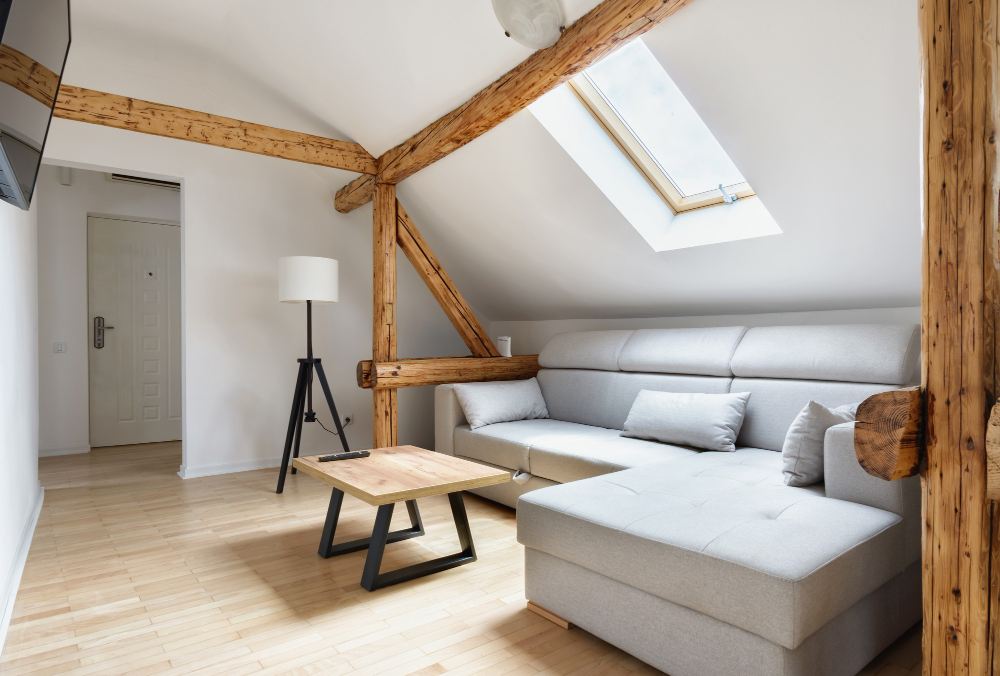
An L-shaped loft conversion is completed by connecting two dormers at right angles, forming a distinctive L shape. This type of conversion is suitable for Victorian terraced and semi-detached houses as such properties have sufficient space for building an additional dormer. The dormer is fixed on the existing roof with the help of wooden beams and a steel frame.
This guide helps you decide whether an L-shaped loft conversion is a good option for your property, along with some important considerations. Moreover, we have provided a detailed cost breakdown to help you better understand the overall budget required for this project.
It helps to enhance your property’s space and increase the head height, allowing you to add extra square footage and multiple rooms in your home. It also opens up the floor space and allows more natural light to enter the rooms with the help of newly installed dormer windows. In this way, you can enhance the living space of your property with added functionality and storage options, eliminating the need to move to a bigger house at a new location.
An L-shaped loft conversion makes your property attractive to potential buyers with added value. Moreover, you can also rent out this extra space to have an extra income stream to meet your daily expenses.
You can also convert the converted loft into a:

The following are some of the significant things to consider for an L-shaped loft conversion:
A survey is one of the foremost stages to start your loft conversion project. By getting a set of existing property drawings, the architectural surveyors will map out the existing condition of your loft to design a bespoke loft conversion. You can expect a fee from £500 to £1,500 that the surveyors will possibly charge.
The minimum head height of a dormer should be between 2m and 2.2m for an L-shaped loft conversion.
According to permitted development guidelines, you can build a loft conversion with up to 50m3 and 40m3 of added volume in a semi-detached and terraced home, respectively. Thus allowing to construct most of the L-shaped loft conversions without needing Planning Permission. However, there are exceptions for the listed buildings and properties located in conservation areas that require Planning Permission approval.
You also need to get Planning Permission approval if the height of your dormer exceeds that of the existing roof’s structure. You will need the approval if bats live inside your loft as they are protected species, and disturbing their home requires a special license. If your neighbours will get affected by the dormer through overlooking or overshadowing and there is a balcony in your dormer, then you will need to get this permission before starting construction.
Moreover, Planning Permission is also required if the material used for constructing the new dormer is not the same as the material used in the entire property structure. Therefore, it is advisable to consult your local council’s planning department to check their requirements regarding the Planning Permission before starting the loft conversion project.
Building Regulations are one of the crucial parts of L-shaped loft conversion and require all the construction work to comply with approval from the local authority’s building control department.
To get the Building Regulations approval, examining the electrical work, fire safety, flashings around windows and dormer, headroom, insulation, plumbing and heating, roof, soundproofing, staircase design and safety, structural stability, and windows and glass is crucial. A structural engineer can charge up to £500 to £1,000 to undertake all the examinations for approval.
A party wall is a wall or boundary shared with your neighbour. You need to carefully assess and sort the party wall matter if your L-shaped loft conversion project will affect your neighbours. For this purpose, you can provide a party wall notice to your neighbours, and if they refuse to give written consent, you will have to hire a party wall surveyor to draft a party wall agreement. A party wall surveyor can charge up to £500 to £1500.

For this type of loft conversion, the entire roof requires removal and rebuilding, which adds up to its cost range from £50,000 to £80,000. This cost varies depending on several factors, such as the loft size, your property’s location, and the material to be installed.
The following is an approximate breakdown of costs in percentage to give you an estimate regarding the costs required for different purposes, such as:
However, the average cost for different components installed during loft conversion varies as follows:
It is crucial to consider all the critical aspects before starting an L-shaped loft conversion project at your property to get the Building Regulations approval and check if Planning Permission is required. Moreover, you should carefully analyse all the costs associated with different phases and components involved in the project to prepare your budget accordingly.